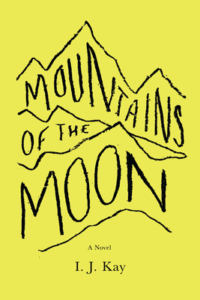The multi-named protagonist of I.J. Kay’s Mountains of the Moon, Lulu (I’ve chosen one, like one chooses a slip of paper out of a hat), doesn’t like to catch sight of herself in the mirror. She never acknowledges that she’s reflected when she does, instead referring to “the woman in the mirror,” abstracting herself from herself. Sometimes, the woman in the mirror goes to answer the door instead of Louise (another one of Lulu’s names), which is the most poignant and accurate depiction of depression I’ve seen since Melancholia. In a way, by calling herself the woman in the mirror, Louise is just taking on another name for herself.
Kay essentially acquaints the reader with three decades of her narrator’s life, from the time she is ten years old through her early thirties. I say “essentially acquaints” because Kay leaves a ten year gap, between Lulu’s early twenties and early thirties, when she was incarcerated for a violent crime that is introduced fuzzily in the beginning and flushed out somewhat by the end. It’s like the old adage (which either is something people actually say or something only people on TV say): you only serve two days in prison, the day you go in and the day you get out. Lulu’s ten years inside are only mentioned, never seen.
Ten-year-old Lulu deals with an absent father, narcissistic mother, and abusive stepfather by pretending to be an African Warrior from one of her books. Following an incident with a tree and her baby brother, Lulu wakes up in a group home as “Catherine Clark.” She runs away, as she runs from everything, and then skulks around the abandoned wing of a mental hospital for a while. A twenty-year-old now called Beverly — or is it Kim? or Jackie? — lives with a friend named Gwen and works at a casino prior to her incarceration. Thirty-year-old Louise, freshly paroled and the recipient of a long overdue workers’ comp payout, travels through Africa.
The narrative moves back and forth through Lulu’s life, in a way that is patterned but not chronological, and is somewhat hard to follow. Kay uses shifting dialects to capture her protagonist at different ages, but Catherine Clark’s abstraction from all the people around her remains consistent, as does the violence. Younger versions of Lulu are more “voicey” — as if the prose reflected the language coming right from Lulu’s brain — than Louise or Kim or Jackie or Catherine, but Kay makes the character seem consistent despite an actual shift in the way she speaks.
Kay’s control of both language and structure is impressive, but unfortunately much of what she does so well isn’t my favorite kind of thing. In general, I don’t like “voicey” prose, and I don’t like hallucinatory shifts that force you over and over again to regain your bearings without giving you a solid enough handrail to hold onto. My personal preferences should not diminish the feat Kay pulled off; I feel as though I know, from toe to forehead, from skin down to bone, a woman who I felt constantly pulled away from by language of the novel.
Mountains of the Moon feels as messy as a life, avoiding a bow-tying ending, blatant allegories, and neat narrative arcs. Kay weaves together a lot of disparate strands: characters that come and go disjointedly, jobs that also come and go disjointedly, snippets of classic musicals by Andrew Lloyd Webber and Stephen Sondheim, good sex, bad sex, our narrator’s shifting names, and even one name change our narrator herself does not understand. Though the novel was hard for me to connect to at times, I had other moments while reading when I felt Lulu had reached out from the page, grabbed me by the throat, and smacked my head against the binding until my nose started bleeding and I gave her my full attention. If only the moments in between hadn’t made me feel like reading was a chore.
This post may contain affiliate links.









